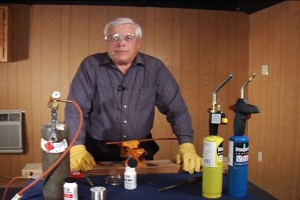The liquid seal — subcooled liquid at the condenser bottom — will prevent air from leaving the condenser. Air will cause a reduction in condenser surface area, which will cause a high condensing pressure.
Air can enter the refrigeration system through a leak in the low side of the refrigeration system. Refrigerant leaks will eventually lead to an undercharged system. Severely undercharged systems can run vacuums on the low side of the system. These vacuums will pull in air from the atmosphere because the low-side (suction) pressure is lower than the atmospheric pressure.
Air may enter the refrigeration system through leaks in the tube, gasket, or flange; poor charging procedures; poor recovery-recycling procedures; or forgetting to purge hoses when accessing systems.
Symptoms of air
The symptoms that exist in a system with air are:- High discharge temperatures;
- High condensing (head) pressures;
- High condensing subcooling;
- High condenser split;
- High compression ratios;
- Normal to slightly high evaporator (suction) pressures;
- Normal superheat; and
- High amp draws.
One school of thought says that with an air-cooled condenser that has a separate receiver, the air will pass through the condenser and reside in the receiver. But if this were the case, there would not be any such thing as condenser or receiver subcooling. The condenser and receiver would be at the same saturation temperature and pressure.
Then there are those who argue that all subcooling would have to take place in a liquid line. But if you place a thermistor or your hand at the condenser’s bottom, it will be cooler than the rest of the condenser. This proves that there is subcooling and that there is a liquid seal at the condenser’s bottom because in order to be subcooled, there cannot be vapor and liquid existing at the same time and place.
How to get rid of it
There is no way for a noncondensable like air to get to the receiver if there is a liquid seal at the condenser’s bottom.The old way to rid air from the top of the condenser was to slowly purge it from the compressor’s discharge service valve, if one existed. This was done with the machine off and soaked to ambient temperatures.
Now, EPA rules require the technician to recover the charge (with air) and purge the air off the top of the recovery tank. This is legal.
In review
As a review, subcooling is defined as the difference between the measured liquid temperature and the liquid saturation temperature at a given pressure.Liquid subcooling starts at the 100% saturated liquid point in the condenser. This means that as soon as the saturated vapor in the condenser changes to saturated liquid, subcooling will start to occur if further heat is removed.
When subcooled, the refrigerant is not generating or losing any vapor pressure, so there is no pressure-temperature relationship and a pressure-temperature chart cannot be used. This is why a thermistor is needed.
Subcooling is needed for the system efficiency and to prevent any liquid flash-gas as the liquid refrigerant travels through any pressure drops before it reaches the TXV.
Liquid can lose heat and subcool further in the receiver, liquid line, and filter-drier before it gets to the metering device.
If, by any chance, liquid refrigerant in the receiver gains enough heat and the receiver losses all of its subcooling, vaporization of the liquid will occur. You now have saturated liquid and vapor in the receiver at a certain saturation temperature. Now you do have both liquid and vapor refrigerant in the receiver.
Refrigerant vapor can also get to the receiver if the condenser loses its liquid seal, maybe from an undercharge of refrigerant, which caused no condenser subcooling. However, if there is any refrigerant vapor in the receiver, the subcooled liquid may not subcool further.
What will happen is the refrigerant vapor will recondense to a liquid in the receiver when any heat is lost and both the remaining liquid and vapor will reach a new saturation temperature.
As you can see, what happens in the receiver depends on many different circumstances. This is why subcooling can be lost if the liquid stays in the receiver too long.




